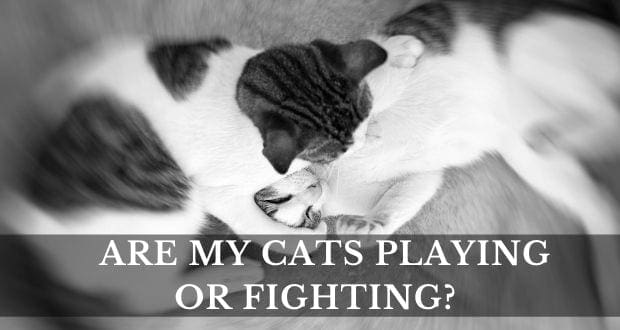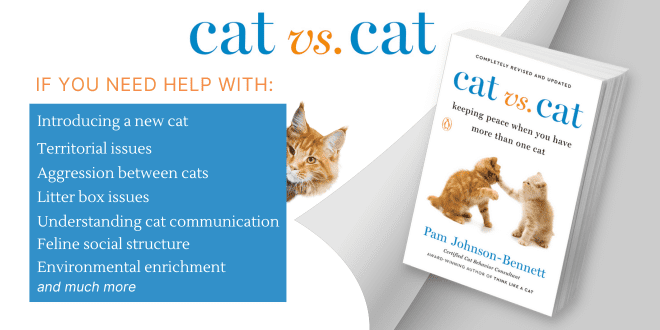
Playtime is an important part of cat life. It’s something that benefits cats, starting in kittenhood and extending all the way through the older years. The way cats play as they age may change but the desire to play should hopefully remain throughout life.
If you live with more than one cat, hopefully, they have a good relationship and spend time playing together. If your cats are kittens, that playtime is also used as a tool for them to learn how gently to bite in order to keep in playtime mode. Kittens also use playtime to learn about their developing skills and practice stalking, chasing, and pouncing. During playtime with their littermates, they also learn important body language and communication skills.
Are My Cats Playing or Fighting?
With adult cats, many still enjoy engaging in playtime with their companions. For some cat parents though, their cats’ playtime may look as if it’s crossed over into aggression. Cat parents are often left unsure about whether the cats are just having an enthusiastic play session or a physical battle that requires intervening before one or both cats get hurt.
There are a few general guidelines to help you when trying to evaluate whether your cats are playing or fighting:
- Play between cats can often look a bit more aggressive than we’d expect. Even between kittens, playtime can look a bit rough. Don’t expect your cats to wrestle and tackle each other with finesse and gentleness. If you’re new at living with cats and are unfamiliar with how they interact with each other, it can be easy to misinterpret playtime exuberance for aggression.
- Cats who normally have a hostile relationship or cats who are unfamiliar with each other won’t typically engage in play together. If you notice two cats who view each other as opponents, are now wrestling, it probably isn’t a friendly encounter. Unfamiliar or hostile cats may develop a friendly relationship and start playing together but that’s something requiring behavior modification and a getting-to-know-you period first. They won’t suddenly go from I hate you to let’s play without interim steps.
- Body language and type of vocalization are important clues for you to determine whether your cats are simply just enjoying a rollicking play session. Here are some typical ones:
- Claws should remain sheathed
- Ears should largely remain in normal position and not pinned back
- No piloerection of hair
- No growling
- No hissing
- Any biting should be minimal and done without causing pain or injury
Wrestling and Chasing Between Cats
When done in play, you should notice the cats take turns. With wrestling, observe whether they each spend equal time being on the top and bottom. If you constantly notice the same cat pinned on the bottom, the encounter may not be playtime. With chasing, it should also be reciprocal. Pay attention to whether you see the same cat always in the position of being pursued.
New or Unfamiliar Cats
If you’ve recently added an additional cat to your family, it’s important to do a careful introduction to encourage the cats to form positive associations with each other. If your approach was to simply put the cats together to “work it out” then the wresting and chasing you see is probably aggressive and in no way falls into the category of fun and games.
What to do if Your Cats are Fighting
Let’s start off with what NOT to do and that’s to never get in-between to try to physically separate them bare-handed. This action will almost certainly cause physical injury to you. In addition to injury to your hands and arms, one or both of the cats could leap toward your face. It can also cause the cats to redirect their aggression toward you in a way that changes their behavior toward you even after the fight is over.
A safer way to separate fighting cats is to make a sudden noise to startle them. Bang a pan against the floor, clap two pot lids together, clap your hands or slam a door or drawer.
If the cats keep going back toward each other, use something safe to block their view of each other so you can usher one cat into another room. A large piece of cardboard, a sofa cushion, whatever is handy that will create a barrier.
Once the cats are separated, lower the lights to help them feel a little more hidden which may create calm. Leave the cats separated until their behavior appears back to normal and they are comfortable interacting with you. How long to keep them separated will depend on the severity of the fight. In some cases, a mini reintroduction may need to be done to help the cats learn to feel comfortable with each other again.
Avoid Cat Fights in the First Place
If your cats have a prickly relationship with each other, take the time now to do behavior work to encourage a more peaceful co-existence. Start by making sure they don’t have to compete for resources. Don’t ask them to share a feeding station or a litter box. Have more than one option available by increasing number and location of all resources. Also, look around the environment and see if it would benefit from being a little more cat friendly. Do you have an adequate number of elevated locations for each cat? Are there hiding places and retreats available for everyone?
In some cases, the reason cats may turn on each other is because they have no other outlet for their energy. Cats are predators who were born to move. Dedicate time each day to engage your cats in interactive play sessions. If your cat’s don’t get along, start by doing individual sessions so they don’t have to compete with each other. In addition to those very valuable interactive playtimes, you can also set up puzzle feeders and puzzle toys to keep your cats occupied when you aren’t home. If the cats have other outlets to satisfy their need for stimulation, they may be less likely to use each other as wrestling opponents.
If your cats normally get along but have a tendency when playing together to let things get a little out of hand, monitor them (without hovering, of course) so you can provide a positive diversion should you sense playtime about to cross over into aggression. Roll a ping pong ball, toss some treats, dangle a fishing pole toy, etc.
Need More Information on Cat Behavior?
For more specifics on cat behavior and cat training in a multicat household, refer to Pam’s book Cat vs. Cat. This best-selling book was the first of its kind to address the special challenges and rewards of living with more than one cat. You can now get your copy of the revised and updated edition in bookstores or online. We’ve included links to Amazon here on our website.
If you’re concerned about aggression between your cats, talk to your veterinarian. If there has been a change in a cat’s behavior there could be an underlying medical cause. If your cat gets a clean bill of health your veterinarian will be able to refer you to a qualified and certified behavior expert.




